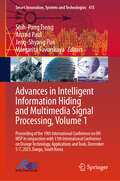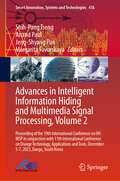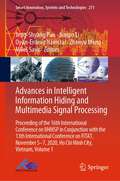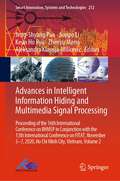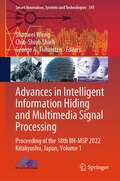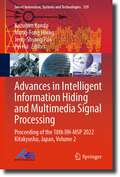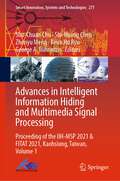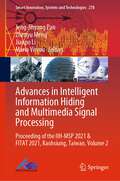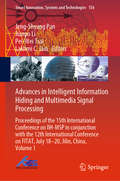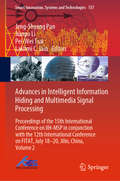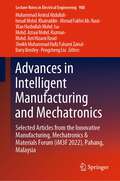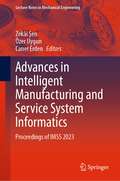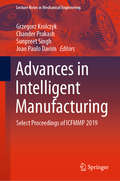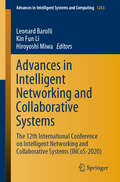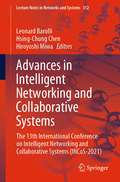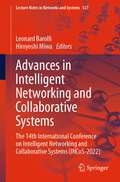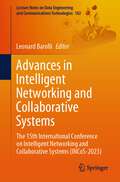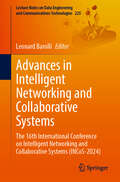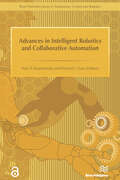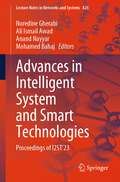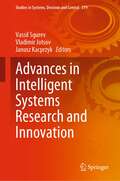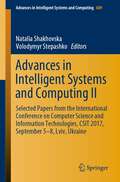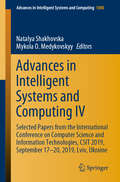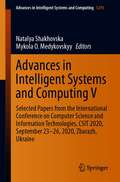- Table View
- List View
Advances in Intelligent Information Hiding and Multimedia Signal Processing, Volume 1: Proceeding of the 19th International Conference on IIH-MSP in conjunction with 11th International Conference on Orange Technology, Applications and Tools, December 5-7, 2023, Daegu, South Korea (Smart Innovation, Systems and Technologies #415)
by Jeng-Shyang Pan Margarita Favorskaya Shih-Pang Tseng Anand PaulThis book presents selected papers from the 19th International Conference on Intelligent Information Hiding and Multimedia Signal Processing, in conjunction with the 11th International Conference on Orange Technology, Applications, and Tools, held on December 5–7, 2023, in Daegu, South Korea. It is divided into two volumes and discusses latest research outcomes in the field of information technology (IT) including but not limited to information hiding, multimedia signal processing, big data, data mining, bioinformatics, database, industrial and internet of things, and their applications.
Advances in Intelligent Information Hiding and Multimedia Signal Processing, Volume 2: Proceeding of the 19th International Conference on IIH-MSP in conjunction with 11th International Conference on Orange Technology, Applications and Tools, December 5-7, 2023, Daegu, South Korea (Smart Innovation, Systems and Technologies #416)
by Jeng-Shyang Pan Margarita Favorskaya Shih-Pang Tseng Anand PaulThis book presents selected papers from the 19th International Conference on Intelligent Information Hiding and Multimedia Signal Processing, in conjunction with the 11th International Conference on Orange Technology, Applications, and Tools, held on December 5–7, 2023, in Daegu, South Korea. It is divided into two volumes and discusses latest research outcomes in the field of information technology (IT) including but not limited to information hiding, multimedia signal processing, big data, data mining, bioinformatics, database, industrial and internet of things, and their applications.
Advances in Intelligent Information Hiding and Multimedia Signal Processing: Proceeding of the 16th International Conference on IIHMSP in conjunction with the 13th international conference on FITAT, November 5-7, 2020, Ho Chi Minh City, Vietnam, Volume 1 (Smart Innovation, Systems and Technologies #211)
by Jeng-Shyang Pan Miloš Savić Jianpo Li Zhenyu Meng Oyun-Erdene NamsraiThis book presents selected papers from the Sixteenth International Conference on Intelligent Information Hiding and Multimedia Signal Processing, in conjunction with the Thirteenth International Conference on Frontiers of Information Technology, Applications and Tools, held on November 5–7, 2020, in Ho Chi Minh City, Vietnam. It is divided into two volumes and discusses the latest research outcomes in the field of Information Technology (IT) including information hiding, multimedia signal processing, big data, data mining, bioinformatics, database, industrial and Internet of things, and their applications.
Advances in Intelligent Information Hiding and Multimedia Signal Processing: Proceeding of the 16th International Conference on IIHMSP in conjunction with the 13th international conference on FITAT, November 5-7, 2020, Ho Chi Minh City, Vietnam, Volume 2 (Smart Innovation, Systems and Technologies #212)
by Jeng-Shyang Pan Jianpo Li Keun Ho Ryu Zhenyu Meng Aleksandra Klasnja-MilicevicThis book presents selected papers from the Sixteenth International Conference on Intelligent Information Hiding and Multimedia Signal Processing, in conjunction with the Thirteenth International Conference on Frontiers of Information Technology, Applications and Tools, held on November 5–7, 2020, in Ho Chi Minh City, Vietnam. It is divided into two volumes and discusses the latest research outcomes in the field of Information Technology (IT) including information hiding, multimedia signal processing, big data, data mining, bioinformatics, database, industrial and Internet of things, and their applications.
Advances in Intelligent Information Hiding and Multimedia Signal Processing: Proceeding of the 18th IIH-MSP 2022 Kitakyushu, Japan, Volume 1 (Smart Innovation, Systems and Technologies #341)
by George A. Tsihrintzis Shaowei Weng Chin-Shiuh ShiehThis book presents selected papers from the 18th International Conference on Intelligent Information Hiding and Multimedia Signal Processing, in conjunction with the 15th International Conference on Frontiers of Information Technology, Applications, and Tools, held on December 16–18, 2022, in Kitakyushu, Japan. It is divided into two volumes and discusses latest research outcomes in the field of information technology (IT) including but not limited to information hiding, multimedia signal processing, big data, data mining, bioinformatics, database, industrial and internet of things, and their applications.
Advances in Intelligent Information Hiding and Multimedia Signal Processing: Proceeding of the 18th IIH-MSP 2022 Kitakyushu, Japan, Volume 2 (Smart Innovation, Systems and Technologies #339)
by Jeng-Shyang Pan Kazuhiro Kondo Mong-Fong Horng Pei HuThe book presents selected papers from the 18th International Conference on Intelligent Information Hiding and Multimedia Signal Processing, held on December 16–18, 2022, in Kitakyushu, Japan. It is divided into two volumes and discusses latest research outcomes in the field of Information Technology (IT) including but not limited to information hiding, multimedia signal processing, big data, data mining, bioinformatics, database, industrial and internet of things, and their applications.
Advances in Intelligent Information Hiding and Multimedia Signal Processing: Proceeding of the IIH-MSP 2021 & FITAT 2021, Kaohsiung, Taiwan, Volume 1 (Smart Innovation, Systems and Technologies #277)
by George A. Tsihrintzis Shu-Chuan Chu Keun Ho Ryu Zhenyu Meng Shi-Huang ChenThe book presents selected papers from the 17th International Conference on Intelligent Information Hiding and Multimedia Signal Processing, in conjunction with the 14th International Conference on Frontiers of Information Technology, Applications and Tools, held on October 29 – 31, 2021, in Kaohsiung, Taiwan. It is divided into two volumes and discusses latest research outcomes in the field of information technology (IT) including but not limited to information hiding, multimedia signal processing, big data, data mining, bioinformatics, database, industrial and Internet of things, and their applications.
Advances in Intelligent Information Hiding and Multimedia Signal Processing: Proceeding of the IIH-MSP 2021 & FITAT 2021, Kaohsiung, Taiwan, Volume 2 (Smart Innovation, Systems and Technologies #278)
by Jeng-Shyang Pan Maria Virvou Jianpo Li Zhenyu MengThis book presents selected papers from the 17th International Conference on Intelligent Information Hiding and Multimedia Signal Processing, in conjunction with the 14th International Conference on Frontiers of Information Technology, Applications and Tools, held on 29–31 October 2021 in Kaohsiung, Taiwan. It is divided into two volumes and discusses latest research outcomes in the field of information technology (IT) including but not limited to information hiding, multimedia signal processing, big data, data mining, bioinformatics, database, industrial and internet of things, and their applications.
Advances in Intelligent Information Hiding and Multimedia Signal Processing: Proceedings of the 15th International Conference on IIH-MSP in conjunction with the 12th International Conference on FITAT, July 18-20, Jilin, China, Volume 1 (Smart Innovation, Systems and Technologies #156)
by Lakhmi C. Jain Jeng-Shyang Pan Pei-Wei Tsai Jianpo LiThe book presents selected papers from the Fifteenth International Conference on Intelligent Information Hiding and Multimedia Signal Processing, in conjunction with the Twelfth International Conference on Frontiers of Information Technology, Applications and Tools, held on July 18–20, 2019 in Jilin, China. Featuring the latest research, it provides valuable information on problem solving and applications for engineers in computer science-related fields, and is a valuable reference resource for academics, industry practitioners and students.
Advances in Intelligent Information Hiding and Multimedia Signal Processing: Proceedings of the 15th International Conference on IIH-MSP in conjunction with the 12th International Conference on FITAT, July 18–20, Jilin, China, Volume 2 (Smart Innovation, Systems and Technologies #157)
by Lakhmi C. Jain Jeng-Shyang Pan Pei-Wei Tsai Jianpo LiThe book presents selected papers from the Fifteenth International Conference on Intelligent Information Hiding and Multimedia Signal Processing, in conjunction with the Twelfth International Conference on Frontiers of Information Technology, Applications and Tools, held on July 18–20, 2019 in Jilin, China. Featuring the latest research, it provides valuable information on problem solving and applications for engineers in computer science-related fields, and is a valuable reference resource for academics, industry practitioners and students.
Advances in Intelligent Manufacturing and Mechatronics: Selected Articles from the Innovative Manufacturing, Mechatronics & Materials Forum (iM3F 2022), Pahang, Malaysia (Lecture Notes in Electrical Engineering #988)
by Ahmad Fakhri Ab. Nasir Pengcheng Liu Ismail Mohd. Khairuddin Muhammad Amirul Abdullah Mohd. Azraai Mohd. Razman Wan Hasbullah Mohd. Isa Mohd. Azri Hizami Rasid Sheikh Muhammad Hafiz Fahami Zainal Barry BentleyThis book presents parts of the iM3F 2022 proceedings from the mechatronics as well as the intelligent manufacturing tracks. It highlights recent trends and key challenges in mechatronics as well as the advent of intelligent manufacturing engineering and technology that are non-trivial in embracing Industry 4.0 as well as addressing the UN Sustainable Development Goals. The book deliberates on conventional as well as advanced solutions that are utilized in the variety of mechatronics and intelligent manufacturing-based applications. The readers are envisaged to gain an insightful view on the current trends, issues, mitigating factors as well as solutions from this book.
Advances in Intelligent Manufacturing and Robotics: Selected Articles from ICIMR 2023; 22-23 August, Suzhou, China (Lecture Notes in Networks and Systems #845)
by Hyun Myung Andrew Tan Leo Chen Fan Zhu Haochuan Jiang Kazi Mostafa Eng Hwa Yap Lillian J. A. OluleThis book presents selected peer reviewed articles from the International Conference on Intelligent Manufacturing and Robotics (ICIMR 2023) held on 22-23 August at the Xi’an Jiaotong-Liverpool University in China. The book deliberates on the key challenges, engineering and scientific discoveries, innovations, and advances in intelligent manufacturing and robotics that are non-trivial through the lens of Industry 4.0. In this book, traditional and modern solutions that are employed across the spectrum of various intelligent manufacturing and robotics contexts are discussed. The book provides an insightful view on the current trends, issues, mitigating factors as well as proposed solutions.
Advances in Intelligent Manufacturing and Service System Informatics: Proceedings of IMSS 2023 (Lecture Notes in Mechanical Engineering)
by Zekâi Şen Caner Erden Özer UygunThis book comprises the proceedings of the 12th International Symposium on Intelligent Manufacturing and Service Systems 2023. The contents of this volume focus on recent technological advances in the field of artificial intelligence in manufacturing & service systems including machine learning, autonomous control, bioinformatics, human-artificial intelligence interaction, digital twin, robotic systems, sybersecurity, etc. This volume will prove a valuable resource for those in academia and industry.
Advances in Intelligent Manufacturing: Select Proceedings of ICFMMP 2019 (Lecture Notes in Mechanical Engineering)
by Chander Prakash Sunpreet Singh Joao Paulo Davim Grzegorz KrolczykThis book consists of select proceedings of the International Conference on Functional Material, Manufacturing and Performances (ICFMMP) 2019, and presents latest research on using the combined intelligence of people, processes, and machines to impact the overall economics of manufacturing. The book focuses on optimizing manufacturing resources, improving business value and safety, and reducing waste – both on the floor and in back-office operations. It highlights the applications of the latest manufacturing execution system (MES), intelligent devices, machine-to-machine communication, and data analysis for the production lines and facilities. This book will be useful to manufacturers of finished goods and of sub-assemblies in the automotive, agriculture, and construction equipment sector. It will also provide solutions to make production strategies exceptional and can be a useful reference for beginners, researchers, and professionals interested in intelligent manufacturing technologies.
Advances in Intelligent Networking and Collaborative Systems: The 12th International Conference on Intelligent Networking and Collaborative Systems (INCoS-2020) (Advances in Intelligent Systems and Computing #1263)
by Leonard Barolli Hiroyoshi Miwa Kin Fun LiThis book aims to provide the latest research findings, innovative research results, methods and development techniques from both theoretical and practical perspectives related to intelligent social networks and collaborative systems, intelligent networking systems, mobile collaborative systems, secure intelligent cloud systems, etc., as well as to reveal synergies among various paradigms in such a multi-disciplinary field intelligent collaborative systems.With the fast development of the Internet, we are experiencing a shift from the traditional sharing of information and applications as the main purpose of the Web to an emergent paradigm, which locates people at the very centre of networks and exploits the value of people's connections, relations and collaboration. Social networks are also playing a major role in the dynamics and structure of intelligent Web-based networking and collaborative systems. Virtual campuses, virtual communities and organizations strongly leverage intelligent networking and collaborative systems by a great variety of formal and informal electronic relations, such as business-to-business, peer-to-peer and many types of online collaborative learning interactions, including the emerging e-learning systems. This has resulted in entangled systems that need to be managed efficiently and in an autonomous way. In addition, latest and powerful technologies based on grid and wireless infrastructure as well as cloud computing are currently enhancing collaborative and networking applications as a great deal but also facing new issues and challenges. The principal purpose of the research and development community is to stimulate research that will lead to the creation of responsive environments for networking and, at longer-term, the development of adaptive, secure, mobile and intuitive intelligent systems for collaborative work and learning.
Advances in Intelligent Networking and Collaborative Systems: The 13th International Conference on Intelligent Networking and Collaborative Systems (INCoS-2021) (Lecture Notes in Networks and Systems #312)
by Leonard Barolli Hsing-Chung Chen Hiroyoshi MiwaThis book provides latest research findings, innovative research results, methods and development techniques from both theoretical and practical perspectives related to intelligent social networks and collaborative systems, intelligent networking systems, mobile collaborative systems, secure intelligent cloud systems, etc., as well as to reveal synergies among various paradigms in such a multi-disciplinary field intelligent collaborative systems. With the fast development of the Internet, we are experiencing a shift from the traditional sharing of information and applications as the main purpose of the Web to an emergent paradigm, which locates people at the very centre of networks and exploits the value of people's connections, relations and collaboration. Social networks are also playing a major role in the dynamics and structure of intelligent Web-based networking and collaborative systems. Virtual campuses, virtual communities and organizations strongly leverage intelligent networking and collaborative systems by a great variety of formal and informal electronic relations, such as business-to-business, peer-to-peer and many types of online collaborative learning interactions, including the emerging e-learning systems. This has resulted in entangled systems that need to be managed efficiently and in an autonomous way. In addition, latest and powerful technologies based on grid and wireless infrastructure as well as cloud computing are currently enhancing collaborative and networking applications a great deal but also facing new issues and challenges. The principal purpose of the research and development community is to stimulate research that will lead to the creation of responsive environments for networking and, at longer-term, the development of adaptive, secure, mobile and intuitive intelligent systems for collaborative work and learning.
Advances in Intelligent Networking and Collaborative Systems: The 14th International Conference on Intelligent Networking and Collaborative Systems (INCoS-2022) (Lecture Notes in Networks and Systems #527)
by Leonard Barolli Hiroyoshi MiwaWith the fast development of the Internet, we are experiencing a shift from the traditional sharing of information and applications as the main purpose of the Web to an emergent paradigm, which locates people at the very center of networks and exploits the value of people's connections, relations, and collaboration. Social networks are also playing a major role in the dynamics and structure of intelligent Web-based networking and collaborative systems. Virtual campuses, virtual communities, and organizations strongly leverage intelligent networking and collaborative systems by a great variety of formal and informal electronic relations, such as business-to-business, peer-to-peer, and many types of online collaborative learning interactions, including the emerging e-learning systems. This has resulted in entangled systems that need to be managed efficiently and in an autonomous way. In addition, latest and powerful technologies based on grid and wireless infrastructure as well as cloud computing are currently enhancing collaborative and networking applications a great deal but also facing new issues and challenges. The principal purpose of the research and development community is to stimulate research that will lead to the creation of responsive environments for networking and, at longer-term, the development of adaptive, secure, mobile, and intuitive intelligent systems for collaborative work and learning. The aim of the book “Advances on Intelligent Networking and Collaborative Systems” is to provide latest research findings, innovative research results, methods, and development techniques from both theoretical and practical perspectives related to intelligent social networks and collaborative systems, intelligent networking systems, mobile collaborative systems, secure intelligent cloud systems, and so on as well as to reveal synergies among various paradigms in such a multi-disciplinary field intelligent collaborative systems.
Advances in Intelligent Networking and Collaborative Systems: The 15th International Conference on Intelligent Networking and Collaborative Systems (INCoS-2023) (Lecture Notes on Data Engineering and Communications Technologies #182)
by Leonard BarolliWith the fast development of the Internet, we are experiencing a shift from the traditional sharing of information and applications as the main purpose of the Web to an emergent paradigm, which locates people at the very center of networks and exploits the value of people's connections, relations, and collaboration. Social networks are also playing a major role in the dynamics and structure of intelligent Web-based networking and collaborative systems. Virtual campuses, virtual communities, and organizations strongly leverage intelligent networking and collaborative systems by a great variety of formal and informal electronic relations, such as business-to-business, peer-to-peer, and many types of online collaborative learning interactions, including the emerging e-learning systems. This has resulted in entangled systems that need to be managed efficiently and in an autonomous way. In addition, latest and powerful technologies based on grid and wireless infrastructure as well as cloud computing are currently enhancing collaborative and networking applications a great deal but also facing new issues and challenges. The principal purpose of the research and development community is to stimulate research that will lead to the creation of responsive environments for networking and, at longer term, the development of adaptive, secure, mobile, and intuitive intelligent systems for collaborative work and learning. The aim of the book is to provide latest research findings, innovative research results, methods and development techniques from both theoretical and practical perspectives related to intelligent social networks and collaborative systems, intelligent networking systems, mobile collaborative systems, secure intelligent cloud systems, etc., as well as to reveal synergies among various paradigms in such a multi-disciplinary field intelligent collaborative systems.
Advances in Intelligent Networking and Collaborative Systems: The 16th International Conference on Intelligent Networking and Collaborative Systems (INCoS-2024) (Lecture Notes on Data Engineering and Communications Technologies #225)
by Leonard BarolliThis book provides latest research findings, innovative research results, methods and development techniques from both theoretical and practical perspectives related to intelligent social networks and collaborative systems, intelligent networking systems, mobile collaborative systems and secure intelligent cloud systems as well as reveals synergies among various paradigms in such a multi-disciplinary field of intelligent collaborative systems. With the fast development of the Internet, there is a shift from the traditional sharing of information and applications as the main purpose of the Web to an emergent paradigm, which locates people at the very center of networks and exploits the value of people's connections, relations and collaboration. Social networks are also playing a major role in the dynamics and structure of intelligent Web-based networking and collaborative systems. Virtual campuses, virtual communities and organizations strongly leverage intelligent networking and collaborative systems by a great variety of formal and informal electronic relations, such as business-to-business, peer-to-peer and many types of online collaborative learning interactions, including the emerging e-learning systems. This has resulted in entangled systems that need to be managed efficiently and in an autonomous way. In addition, latest and powerful technologies based on grid and wireless infrastructure as well as cloud computing are currently enhancing collaborative and networking applications a great deal but also facing new issues and challenges. The principal purpose of the research and development community is to stimulate research that will lead to the creation of responsive environments for networking and, at longer-term, the development of adaptive, secure, mobile and intuitive intelligent systems for collaborative work and learning.
Advances in Intelligent Robotics and Collaborative Automation (River Publishers Series In Automation, Control And Robotics Ser.)
by Yuriy Kondratenko Richard DuroThis book provides an overview of a series of advanced research lines in robotics as well as of design and development methodologies for intelligent robots and their intelligent components. It represents a selection of extended versions of the best papers presented at the Seventh IEEE International Workshop on Intelligent Data Acquisition and Advanced Computing Systems: Technology and Applications IDAACS 2013 that were related to these topics. Its contents integrate state of the art computational intelligence based techniques for automatic robot control to novel distributed sensing and data integration methodologies that can be applied to intelligent robotics and automation systems. The objective of the text was to provide an overview of some of the problems in the field of robotic systems and intelligent automation and the approaches and techniques that relevant research groups within this area are employing to try to solve them.The contributions of the different authors have been grouped into four main sections:• Robots• Control and Intelligence• Sensing• Collaborative automationThe chapters have been structured to provide an easy to follow introduction to the topics that are addressed, including the most relevant references, so that anyone interested in this field can get started in the area.
Advances in Intelligent System and Smart Technologies: Proceedings of I2ST’23 (Lecture Notes in Networks and Systems #826)
by Ali Ismail Awad Mohamed Bahaj Anand Nayyar Noredine GherabiThis book is a collection of high-quality peer-reviewed research papers presented at The International Conference on Intelligent Systems and Smart Technologies (I2ST’23) held at the Faculty of Science and Technology of Hassan First University, Morocco, on January 17–18, 2023. I2ST'23 is a forum for presenting new advances and research results in the fields of information, communication, and smart technologies. The book discusses significant issues relating to machine learning, smart technologies, and data analytics. The main and distinctive topics covered are: I) AI& Intelligent, II) Systems Smart Technologies, III) Communications and Networking, IV) Software Engineering & Web Applications, V) Information Technology, and VI) Software Engineering & Web Applications.
Advances in Intelligent Systems Research and Innovation (Studies in Systems, Decision and Control #379)
by Janusz Kacprzyk Vassil Sgurev Vladimir JotsovThis book represents the experience of successful researchers from four continents on a broad range of intelligent systems, and it hints how to avoid anticipated conflicts and problems during multidisciplinary innovative research from Industry 4.0 and/or Internet of Things through modern machine learning, and software agent applications to open data science big data/advance analytics/visual analytics/text mining/web mining/knowledge discovery/deep data mining issues. The considered intelligent part is essential in most smart/control systems, cyber security, bioinformatics, virtual reality, robotics, mathematical modelling projects, and its significance rapidly increases in other technologies. Theoretical foundations of fuzzy sets, mathematical and non-classical logic also are rapidly developing.
Advances in Intelligent Systems and Computing II: Selected Papers from the International Conference on Computer Science and Information Technologies, CSIT 2017, September 5-8 Lviv, Ukraine (Advances in Intelligent Systems and Computing #689)
by Natalia Shakhovska Volodymyr StepashkoThis book reports on new theories and applications in the field of intelligent systems and computing. It covers computational and artificial intelligence methods, as well as advances in computer vision, current issues in big data and cloud computing, computation linguistics, and cyber-physical systems. It also reports on data mining and knowledge extraction technologies, as well as central issues in intelligent information management. Written by active researchers, the respective chapters are based on papers presented at the International Conference on Computer Science and Information Technologies (CSIT 2017), held on September 5–8, 2017, in Lviv, Ukraine; and at two workshops accompanying the conference: one on inductive modeling, jointly organized by the Lviv Polytechnic National University and the National Academy of Science of Ukraine; and another on project management, which was jointly organized by the Lviv Polytechnic National University, the International Project Management Association, the Ukrainian Project Management Association, the Kazakhstan Project Management Association, and Nazarbayev University. Given its breadth of coverage, the book provides academics and professionals with extensive information and a timely snapshot of the field of intelligent systems, and is sure to foster new discussions and collaborations among different groups.
Advances in Intelligent Systems and Computing IV: Selected Papers from the International Conference on Computer Science and Information Technologies, CSIT 2019, September 17-20, 2019, Lviv, Ukraine (Advances in Intelligent Systems and Computing #1080)
by Natalya Shakhovska Mykola O. MedykovskyyThis book reports on new theories and applications in the field of intelligent systems and computing. It covers computational and artificial intelligence methods, as well as advances in computer vision, current issues in big data and cloud computing, computation linguistics, and cyber-physical systems. It also reports on important topics in intelligent information management. Written by active researchers, the respective chapters are based on selected papers presented at the XIV International Scientific and Technical Conference on Computer Science and Information Technologies (CSIT 2019), held on September 17–20, 2019, in Lviv, Ukraine. The conference was jointly organized by the Lviv Polytechnic National University, Ukraine, the Kharkiv National University of Radio Electronics, Ukraine, and the Technical University of Lodz, Poland, under patronage of Ministry of Education and Science of Ukraine. Given its breadth of coverage, the book provides academics and professionals with extensive information and a timely snapshot of the field of intelligent systems, and is sure to foster new discussions and collaborations among different groups.
Advances in Intelligent Systems and Computing V: Selected Papers from the International Conference on Computer Science and Information Technologies, CSIT 2020, September 23-26, 2020, Zbarazh, Ukraine (Advances in Intelligent Systems and Computing #1293)
by Natalya Shakhovska Mykola O. MedykovskyyThis book reports on new theories and applications in the field of intelligent systems and computing. It covers cutting-edge computational and artificial intelligence methods, advances in computer vision, big data, cloud computing, and computation linguistics, as well as cyber-physical and intelligent information management systems. The respective chapters are based on selected papers presented at the workshop on intelligent systems and computing, held during the International Conference on Computer Science and Information Technologies, CSIT 2020, which was jointly organized on September 23-26, 2020, by the Lviv Polytechnic National University, Ukraine, the Kharkiv National University of Radio Electronics, Ukraine, and the Technical University of Lodz, Poland, under patronage of Ministry of Education and Science of Ukraine.Given its breadth of coverage, the book provides academics and professionals with extensive information and a timely snapshot of the field of intelligent systems, and is sure to foster new discussions and collaborations among different groups.
